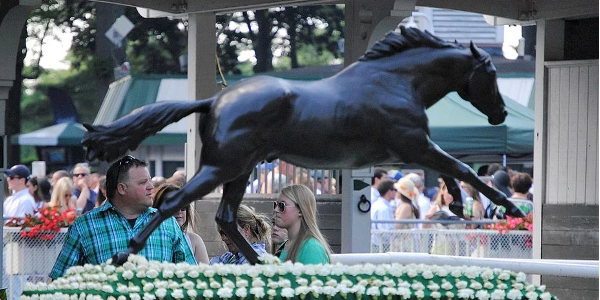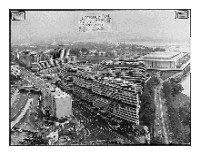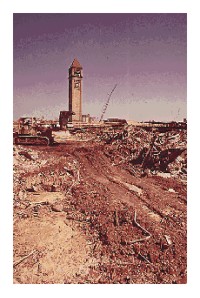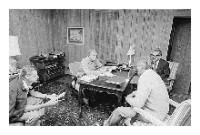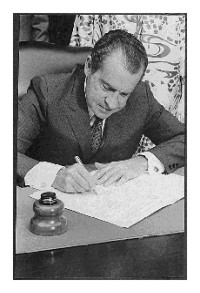
Photo above: President Richard Nixon. Courtesy National Archives. Right: Statue of Secretariat at Belmont Park, 2014, courtesy Wikipedia Commons.
Sponsor this page for $100 per year. Your banner or text ad can fill the space above.
Click here to Sponsor the page and how to reserve your ad.
-
Timeline
1972 - Detail
February 21, 1972 - The journey for peace trip of the U.S. President to Peking, China begins. The eight day journey by Richard M. Nixon and meetings with Mao Zedong, unprecedented at the time, began the process for normalization of relations with China.
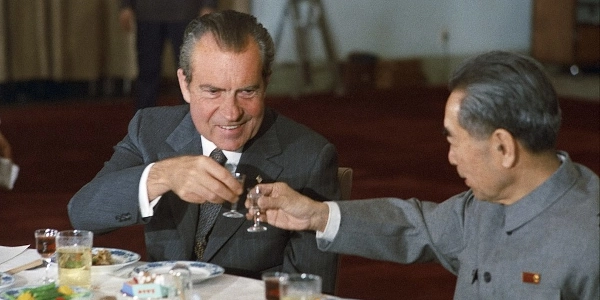
Several of President Nixon's goals on the foreign relations front in 1972 was to smooth relations with two of his foremost adversaries on the world stage. He wanted to normalize relations with both China and the Soviet Union, and discuss ways to get there. Nixon had been a strong advocate and experienced in foreign relation trips, with his kitchen discussion at a small American Exhibition in Russia while Vice President in 1959 discussed the merits of capitalism versus communism with Premier Nikita Khrushchev. The conversation, in some ways, shocked the world showing Nixon's strength. First up, in 1972, he would visit Peking and meet its Premier Zhou Enlai and China's formidible Chairman Mao Zedong. Relations with China had been strained since the Korean War, and China, backing North Vietnam during the ongoing Vietnam conflict, had not warmed to peace or trade with the United States yet.
However, the Nixon administration had been making small gestures toward an eventual peace conference. Even before becoming President, he had written on the subject. At the time, National Security Advisor Henry Kissinger was his main ally on the topic. China and the Soviet Union were not on the closest terms, even involved in several border clashes. Both Nixon and Kissinger saw this as an opportunity. Nixon sent word that the United States sought closer relations with China. Mao Zedong responded by inviting American table tennis players to China to compete against Chinese players, and Kissinger secretly met with Chinese officials in China. On July 15, 1971, the world was shocked when Washington and Peking announced a summit for the following February.
How the Meeting Progressed
Nixon was briefed for forty hours prior to the President and First Lady landing in Peking, greeted by the Chinese Premier Zhou Enlai. They shook hands, something that former Secretary of State John Foster Dulles had not done in 1954. This apparently impressed Zhou, and they would later meet again during a state dinner. In China, the Premier's position in under the Chairman, i.e. Mao Zedong.
President Nixon and Security Advisor Henry Kissinger met with Chairman Mao and Premier Zhou for over one hour in the private residence of the Chairman, discussing a variety of issues. It is said that Mao appreciated Nixon's forthrightness, but did not trust Kissinger. That evening, a formal dinner was held at the Great Hall of the People.
Nixon met with Zhou the next day; a communique known as the Shanghai Communique, was issued after the meeting. The U.S. stated that Taiwan was part of China and that reunification should be sought, even though that did not make it into the document, a policy that would change as history progressed and was against current U.S. protocol anyway. For U.S. China relations, it was the beginning of a new era. It also forced the Soviet Union to come to the table with the United States as they now feared a U.S. and China alliance.
Shanghai Communique, February 27, 1972
February 27, 1972
JOINT COMMUNIQUE
February 28, 1972
Shanghai, People's Republic of China
Joint Communiqué of the United States of America and the People's Republic of China (Shanghai Communiqué)
President Richard Nixon of the United States of America visited the People's Republic of China at the invitation of Premier Chou En-lai of the People's Republic of China from February 21 to February 28, 1972. Accompanying the President were Mrs. Nixon, US Secretary of State William Rogers, Assistant to the President Dr. Henry Kissinger, and other American officials.
President Nixon met with Chairman Mao Tsetung of the Communist Party of China on February 21. The two leaders had a serious and frank exchange of views on Sino-US relations and world affairs.
During the visit, extensive, earnest and frank discussions were held between President Nixon and Premier Chou En-lai on the normalization of relations between the United States of America and the People's Republic of China, as well as on other matters of interest to both sides. In addition, Secretary of State William Rogers and Foreign Minister Chi Peng-fei held talks in the same spirit.
President Nixon and his party visited Peking and viewed cultural, industrial and agricultural sites, and they also toured Hangchow and Shanghai where, continuing discussions with Chinese leaders, they viewed similar places of interest.
The leaders of the People's Republic of China and the United States of America found it beneficial to have this opportunity, after so many years without contact, to present candidly to one another their views on a variety of issues. They reviewed the international situation in which important changes and great upheavals are taking place and expounded their respective positions and attitudes.
The Chinese side stated: Wherever there is oppression, there is resistance. Countries want independence, nations want liberation and the people want revolution--this has become the irresistible trend of history. All nations, big or small, should be equal: big nations should not bully the small and strong nations should not bully the weak. China will never be a superpower and it opposes hegemony and power politics of any kind. The Chinese side stated that it firmly supports the struggles of all the oppressed people and nations for freedom and liberation and that the people of all countries have the right to choose their social systems according their own wishes and the right to safeguard the independence, sovereignty and territorial integrity of their own countries and oppose foreign aggression, interference, control and subversion. All foreign troops should be withdrawn to their own countries. The Chinese side expressed its firm support to the peoples of Viet Nam, Laos and Cambodia in their efforts for the attainment of their goal and its firm support to the seven-point proposal of the Provisional Revolutionary Government of the Republic of South Viet Nam and the elaboration of February this year on the two key problems in the proposal, and to the Joint Declaration of the Summit Conference of the Indochinese Peoples. It firmly supports the eight-point program for the peaceful unification of Korea put forward by the Government of the Democratic People's Republic of Korea on April 12, 1971, and the stand for the abolition of the "UN Commission for the Unification and Rehabilitation of Korea". It firmly opposes the revival and outward expansion of Japanese militarism and firmly supports the Japanese people's desire to build an independent, democratic, peaceful and neutral Japan. It firmly maintains that India and Pakistan should, in accordance with the United Nations resolutions on the Indo-Pakistan question, immediately withdraw all their forces to their respective territories and to their own sides of the ceasefire line in Jammu and Kashmir and firmly supports the Pakistan Government and people in their struggle to preserve their independence and sovereignty and the people of Jammu and Kashmir in their struggle for the right of self-determination.

Overall Outcome of Nixon's Visit Fifty Years Later
The opening of China was seen by most observers as the most impressive achievement of the Nixon presidency. However, and this is just our opinion, you could today say it was just the opposite. It would lead to advancements, with the assistance of the United States and multi-national corporations, in the capacity of China in all areas. That would unfortunately drive industry in the United States toward the lower labor cost factories in China as one by one most large scale manufacturers chose higher profits over U.S. economic health and national security.
It also created, with the wealth established through that unbalanced trade which favored China, a military state that has risen to parity or superiority with almost all nation's on earth. All this with almost no attention by the civilized world in demanding human rights be part of the trade. Today, in 2022, we have just endured several years and millions of deaths worldwide due to a Covid-19 outbreak which began in a Chinese lab doing risky research, or accidentally in a Chinese wet market. Our opinion leans toward the former, but neither we, nor the world, may never know.
In 1982, during the Knoxville World's Fair, which focused on the topic of energy, China exhibited for the first time. However, they did not have an energy industry or capacity at that time to exhibit in an appropriate way on that subject. It was striking, yet beautiful, that their exhibit focused on origami and caligraphy from craftsmen, showing that their society was still mostly cultural and agricultural.
Over the forty years since that event, it has become evident that one statement in the Shanghai Communique really stands out as inaccurate, ... "China will never be a superpower." But that, essentially, is what the opening of China by President Nixon and greedy multi-national corporations have created.
Photo above: President Richard Nixon and Chinese Premier Zhou Enla toast, February 25, 1972, White House Photographer. Courtesy Nixon Presidential Library via Wikipedia Commons. Photo below: Montage (left) President Richard Nixon Presidential Portrat, 1969-1975, Department of Defense. Courtesy Wikipedia Commons; (right) State of Chairman Mao, 1983, Balthazar Korab Studios, Ltd. Courtesy Korab collection in Library of Congress. Source info: U.S. Department of Defense, Wilson Center Digital Archives; Wikipedia Commons.
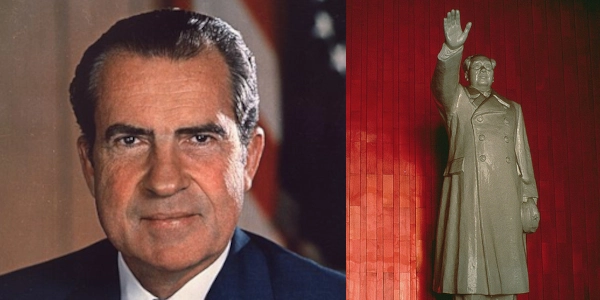

President Nixon and Security Advisor Henry Kissinger met with Chairman Mao and Premier Zhou for over one hour in the private residence of the Chairman, discussing a variety of issues. It is said that Mao appreciated Nixon's forthrightness, but did not trust Kissinger. That evening, a formal dinner was held at the Great Hall of the People.
Nixon met with Zhou the next day; a communique known as the Shanghai Communique, was issued after the meeting. The U.S. stated that Taiwan was part of China and that reunification should be sought, even though that did not make it into the document, a policy that would change as history progressed and was against current U.S. protocol anyway. For U.S. China relations, it was the beginning of a new era. It also forced the Soviet Union to come to the table with the United States as they now feared a U.S. and China alliance.
JOINT COMMUNIQUE
February 28, 1972
Shanghai, People's Republic of China
Joint Communiqué of the United States of America and the People's Republic of China (Shanghai Communiqué)
President Richard Nixon of the United States of America visited the People's Republic of China at the invitation of Premier Chou En-lai of the People's Republic of China from February 21 to February 28, 1972. Accompanying the President were Mrs. Nixon, US Secretary of State William Rogers, Assistant to the President Dr. Henry Kissinger, and other American officials.
President Nixon met with Chairman Mao Tsetung of the Communist Party of China on February 21. The two leaders had a serious and frank exchange of views on Sino-US relations and world affairs.
During the visit, extensive, earnest and frank discussions were held between President Nixon and Premier Chou En-lai on the normalization of relations between the United States of America and the People's Republic of China, as well as on other matters of interest to both sides. In addition, Secretary of State William Rogers and Foreign Minister Chi Peng-fei held talks in the same spirit.
President Nixon and his party visited Peking and viewed cultural, industrial and agricultural sites, and they also toured Hangchow and Shanghai where, continuing discussions with Chinese leaders, they viewed similar places of interest.
The leaders of the People's Republic of China and the United States of America found it beneficial to have this opportunity, after so many years without contact, to present candidly to one another their views on a variety of issues. They reviewed the international situation in which important changes and great upheavals are taking place and expounded their respective positions and attitudes.
The Chinese side stated: Wherever there is oppression, there is resistance. Countries want independence, nations want liberation and the people want revolution--this has become the irresistible trend of history. All nations, big or small, should be equal: big nations should not bully the small and strong nations should not bully the weak. China will never be a superpower and it opposes hegemony and power politics of any kind. The Chinese side stated that it firmly supports the struggles of all the oppressed people and nations for freedom and liberation and that the people of all countries have the right to choose their social systems according their own wishes and the right to safeguard the independence, sovereignty and territorial integrity of their own countries and oppose foreign aggression, interference, control and subversion. All foreign troops should be withdrawn to their own countries. The Chinese side expressed its firm support to the peoples of Viet Nam, Laos and Cambodia in their efforts for the attainment of their goal and its firm support to the seven-point proposal of the Provisional Revolutionary Government of the Republic of South Viet Nam and the elaboration of February this year on the two key problems in the proposal, and to the Joint Declaration of the Summit Conference of the Indochinese Peoples. It firmly supports the eight-point program for the peaceful unification of Korea put forward by the Government of the Democratic People's Republic of Korea on April 12, 1971, and the stand for the abolition of the "UN Commission for the Unification and Rehabilitation of Korea". It firmly opposes the revival and outward expansion of Japanese militarism and firmly supports the Japanese people's desire to build an independent, democratic, peaceful and neutral Japan. It firmly maintains that India and Pakistan should, in accordance with the United Nations resolutions on the Indo-Pakistan question, immediately withdraw all their forces to their respective territories and to their own sides of the ceasefire line in Jammu and Kashmir and firmly supports the Pakistan Government and people in their struggle to preserve their independence and sovereignty and the people of Jammu and Kashmir in their struggle for the right of self-determination.

It also created, with the wealth established through that unbalanced trade which favored China, a military state that has risen to parity or superiority with almost all nation's on earth. All this with almost no attention by the civilized world in demanding human rights be part of the trade. Today, in 2022, we have just endured several years and millions of deaths worldwide due to a Covid-19 outbreak which began in a Chinese lab doing risky research, or accidentally in a Chinese wet market. Our opinion leans toward the former, but neither we, nor the world, may never know.
In 1982, during the Knoxville World's Fair, which focused on the topic of energy, China exhibited for the first time. However, they did not have an energy industry or capacity at that time to exhibit in an appropriate way on that subject. It was striking, yet beautiful, that their exhibit focused on origami and caligraphy from craftsmen, showing that their society was still mostly cultural and agricultural.
Over the forty years since that event, it has become evident that one statement in the Shanghai Communique really stands out as inaccurate, ... "China will never be a superpower." But that, essentially, is what the opening of China by President Nixon and greedy multi-national corporations have created.
Photo above: President Richard Nixon and Chinese Premier Zhou Enla toast, February 25, 1972, White House Photographer. Courtesy Nixon Presidential Library via Wikipedia Commons. Photo below: Montage (left) President Richard Nixon Presidential Portrat, 1969-1975, Department of Defense. Courtesy Wikipedia Commons; (right) State of Chairman Mao, 1983, Balthazar Korab Studios, Ltd. Courtesy Korab collection in Library of Congress. Source info: U.S. Department of Defense, Wilson Center Digital Archives; Wikipedia Commons.



